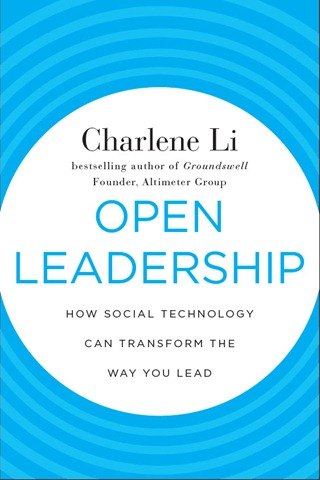Charlene Li’s latest book challenges executives to ask one big question … and many other little ones
[NOTE: Charlene Li discusses her book at the kick-off of BroadVision’s new speaker and social-networking series, Clearvale SecondFloor, August 18]

I am not a big fan of business books — at least those that put forward a simple theory that can be applied across all fields, all disciplines, all walks of life. I’ll admit to liking some of these — particularly when the writing is good — but I tend to prefer the very rare business book that poses a serious question — or questions — in a more story-driven narrative. Example: former BusinessWeek reporter Anthony Bianco’s THE BIG LIE, a story about the evolution of HP’s current board of directors, and the “pretexting” scandal that engulphed the company several years ago. There are several important questions in this book embedded in the narrative — questions about corporate governance, about the difficulty in living up to a corporate legend, about the moral requirements of executive leadership — but you wouldn’t mistake THE BIG LIE for anything other than the potboiler it is. Bianco’s book was published in May, just a few months before the current HP scandal broke, but I suspect it’s getting another look by business people looking for infotainment at the beach this summer. Prediction = THE BIG LIE will become a bestseller on Kindle over the Labor Day weekend.
Truth is, it’s harder to write the other kind of business book — the one that doesn’t necessarily tell a Hollywood-grade story, but that instead puts forth an intellectually or emotionally compelling argument for what a business person should do in the face of big business challenges. Charlene Li — the well-known social technology consultant and founder of The Altimeter Group — has succeeded in that category with OPEN LEADERSHIP, a new look at social technology that reaches the reader intellectually and emotionally by taking another tack: by challenging you, the reader (the business executive, and proxy for your company), to honestly examine, “how open are you?”
The premise here has been covered in other books, and it goes something like this: a number of forces, including the social tech revolution, are bringing inevitable changes to the enterprise. And one of those changes is “loss of control.” OPEN LEADERSHIP, like other good social tech books, presents case studies that illustrate how business leaders are not just coping with these forces, but innovating as well. But unlike other books of this genre, Li’s book puts executive readers — the people who can support or stop change at their companies — into the narrative. Running that reader through a step-by-step “openness audit,” she takes the conversation down from the level of abstraction where most business books live, and forces the reader to engage as the protagonist in a future story – the story of what an executive might do in a world where one can no longer rely on “command and control.” Soon after you are done with the audit, Li asks the question, “now that you know how open you are, let’s look at how open you need to be.”
It’s at this point in the journey – pretty early in the book – that you are likely to first feel the emotional impact of OPEN LEADERSHIP – especially if you work in a traditional corporate work environment. For many companies, the gap between current state and future state is significant. But Li does a nice job of breaking down the journey into smaller steps – drafting a “covenant” (not “contract” — a more modern but less socially savvy construct) to get agreement and alignment with the different constituencies that make up a social tech program; designing your program to meet clearly defined business objectives; driving adoption (a fatal weakness for many if not most social tech programs); dealing with curmudgeons, and other late adopters; teaming early adopters and late adopters as a strategy for eliminating roadblocks. One of my favorite sections is on measurement, a topic most people in my world find impossible. Li quotes John Hayes, CMO at American Express: “we tend to overvalue the things we can measure, and undervalue the things we cannot.” Completely agree. But I love Li’s suggestion that we look at metrics like Net Promoter Score, which measures success according to how much business your network delivers and refers. It’s a testament to Li’s professional integrity that she doesn’t give short shrift to measurement, but instead make a case for the most innovative thinking on this subject in the post-2.0 era.
But my favorite section comes later — in the last chapter. Li closes with six mini case studies of people who really take up the challenge of open leadership and set out to transform their organizations. We’re talking about big, complex, seemingly unmanageable orgs, with not too much in common, at least on the surface: Cisco, Dell, P&G, the State Bank of India, US Department of State, and Best Buy (full disclosure, my former client). You may feel a thrill here and there as you go through this chapter. And if you do it’s perhaps because you can relate to one of the protagonists in these little stories. And that’s the great charm in Li’s smart book, which makes the individual reader the main protagonist. Though the story for each reader is yet to be written, the book lays out the steps almost as effectively as a users manual. Not exactly the kind of book you’d bring to the beach on Labor Day weekend, but most definitely the kind of book you’d like on your desk when you are done with THE BIG LIE, and are ready to get back to work.
